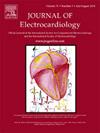Machine-learning computer-assisted ECG analysis to predict myocardial fibrosis in patients with hypertrophic cardiomyopathy
IF 1.3
4区 医学
Q3 CARDIAC & CARDIOVASCULAR SYSTEMS
引用次数: 0
Abstract
Aims
The application of computer assisted techniques to the electrocardiogram (ECG) analysis is showing promising results. Our main aim was to apply a machine learning approach to the ECG analysis in patients with hypertrophic cardiomyopathy (HCM), to identify predictors of macroscopic fibrosis, a marker of ventricular arrhythmias and sudden cardiac death.
Methods
136 patients diagnosed with HCM were included. The main clinical and echocardiographic variables were collected. All patients underwent cardiac magnetic resonance (CMR) and the presence of macroscopic fibrosis was assessed on late gadolinium enhancement (LGE) sequences. From the 12‑lead digitized ECGs of each patient 468 morphological variables were quantified with a dedicated software.
Results
The mean age of the population was 62.6 ± 14.1 years, and in 82 patients (60.3 %) LGE was observed. After preselecting significant ECG variables from the univariate analysis, a multivariate regression was performed, obtaining a predictive model composed of five parameters: the duration of the QRS in I, the duration of the QT interval in V3, the duration of the T wave in aVF, the peak-to peak amplitude of the QRS in V1, and the amplitude of the S wave in V4. A random forest algorithm confirmed that the duration of the QRS was the strongest predictor of fibrosis.
Conclusion
In patients with HCM the addition of a computer-assisted ECG analysis can help to identify predictors of LGE, being the duration of the QRS the strongest one. Our findings can be especially useful when access to CMR is scarce, to select patients at higher risk.
机器学习计算机辅助心电图分析预测肥厚性心肌病患者的心肌纤维化
目的计算机辅助技术在心电图分析中的应用正显示出良好的效果。我们的主要目的是将机器学习方法应用于肥厚性心肌病(HCM)患者的心电图分析,以确定宏观纤维化的预测因素,这是室性心律失常和心源性猝死的标志。方法选取136例确诊为HCM的患者。收集主要临床和超声心动图变量。所有患者均接受心脏磁共振(CMR)检查,并通过晚期钆增强(LGE)序列评估宏观纤维化的存在。从每位患者的12导联数字化心电图中,用专用软件对468个形态学变量进行量化。结果本组患者平均年龄为62.6±14.1岁,有82例(60.3%)出现LGE。从单因素分析中预选有意义的心电图变量后,进行多因素回归,得到由I期QRS持续时间、V3期QT间期持续时间、aVF期T波持续时间、V1期QRS峰对峰幅度、V4期S波幅度5个参数组成的预测模型。随机森林算法证实QRS的持续时间是纤维化的最强预测因子。结论在HCM患者中,加入计算机辅助心电图分析有助于识别LGE的预测因素,其中QRS的持续时间是最强的预测因素。我们的研究结果在缺乏CMR的情况下特别有用,可以选择高风险患者。
本文章由计算机程序翻译,如有差异,请以英文原文为准。
求助全文
约1分钟内获得全文
求助全文
来源期刊

Journal of electrocardiology
医学-心血管系统
CiteScore
2.70
自引率
7.70%
发文量
152
审稿时长
38 days
期刊介绍:
The Journal of Electrocardiology is devoted exclusively to clinical and experimental studies of the electrical activities of the heart. It seeks to contribute significantly to the accuracy of diagnosis and prognosis and the effective treatment, prevention, or delay of heart disease. Editorial contents include electrocardiography, vectorcardiography, arrhythmias, membrane action potential, cardiac pacing, monitoring defibrillation, instrumentation, drug effects, and computer applications.
 求助内容:
求助内容: 应助结果提醒方式:
应助结果提醒方式:


